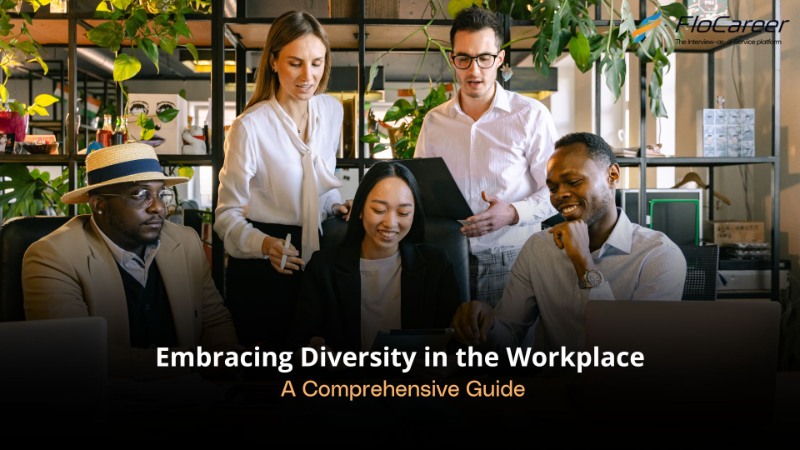Embracing Diversity in the Workplace: A Comprehensive Guide
Diversity in the workplace has emerged as a crucial aspect of organizational success, offering numerous advantages that extend beyond mere trends. Companies that embrace diversity tend to be more vibrant, productive, and competitive in today's dynamic business landscape. In this article, we'll delve into the multifaceted concept of workplace diversity, exploring its various types and providing insights on fostering an inclusive professional environment.

Understanding Diversity in the Workplace
Diversity in the workplace is more than a buzzword; it's a cornerstone of a progressive and forward-thinking organizational culture. It involves intentionally creating a workforce that embodies various characteristics, including but not limited to gender, age, religion, language, socioeconomic background, and educational history. The goal is to establish an inclusive environment that values and appreciates the unique perspectives and experiences each employee brings, fostering innovation and dynamism.
Exploring Types of Workplace Diversity
Internal Diversity: Encompassing inherent traits such as race, ethnicity, and gender, internal diversity recognizes and values qualities that individuals possess from birth.
External Diversity: Shaping a person's identity post-birth, external diversity includes factors like socioeconomic status, education, marital status, religion, appearance, and location.
Organizational Diversity: This type focuses on recognizing differences in job roles, work backgrounds, experience levels, departments, and management positions, emphasizing the value of a diverse skill set.
Worldview Diversity: Involving beliefs, political affiliations, cultures, and travel experiences, worldview diversity contributes to a forward-thinking atmosphere that promotes innovation.
Strategies to Encourage Diversity in the Workplace
Inclusive Hiring Practices: Foster diversity by considering candidates from various backgrounds, eliminating unnecessary barriers, and diversifying interview panels to ensure a broad perspective.
Employee Groups: Create spaces where individuals can connect based on shared backgrounds or interests, implementing employee resource groups to foster a sense of inclusion and community.
Inclusive Leadership: Recognize the pivotal role of leadership in setting the organizational tone. Inclusive leadership, especially at higher levels, reinforces core values and improves decision-making.
Transparency: Cultivate a culture of openness regarding diversity initiatives, seeking input from teams through regular meetings and feedback mechanisms to build trust.
Allyship: Take a firm stance on social justice matters, confronting discrimination and harassment issues. Ensure organizational declarations align with the everyday experiences of your workforce.
Be Vulnerable: Encourage diverse perspectives by actively inviting contributions from all team members, fostering an environment where dissenting opinions are welcomed for inclusivity and innovation.
Do the Research: Educate your team about the tangible benefits of workplace diversity, emphasizing that it leads to increased employee satisfaction, improved health, longer retention, and enhanced productivity.
Cultivate an Inclusive Company Culture:
Actively promote an inclusive company culture that values diversity. Ensure that company policies, communication, and practices reflect a commitment to fairness and equal opportunities for all employees. Cultivating an inclusive culture fosters a sense of belonging among the workforce.
Diversity Training for Leadership:
Provide specialized diversity training for leaders and managers to equip them with the skills needed to lead diverse teams effectively. This training should focus on fostering inclusive leadership behaviors, addressing unconscious biases, and promoting a culture of respect and equality.
Accessibility Initiatives:
Implement accessibility initiatives to make the workplace physically and digitally inclusive. Ensure that facilities are accessible to employees with disabilities, and digital platforms are designed to accommodate various needs, including those related to vision, hearing, and mobility.
Language Inclusivity:
Recognize and accommodate language diversity within the organization. Offer language courses or communication resources for employees whose first language may not be the primary language of the workplace. This ensures effective communication and collaboration across diverse linguistic backgrounds.
Supplier Diversity Programs:
Extend diversity initiatives beyond the workforce by implementing supplier diversity programs. Actively seek out and engage with suppliers from minority-owned businesses, women-owned enterprises, and other diverse backgrounds. This approach contributes to a more inclusive and equitable business ecosystem.
Regular Diversity Events:
Organize regular diversity events and celebrations throughout the year. These events can focus on cultural heritage months, important historical milestones, or awareness campaigns. They provide opportunities for education, dialogue, and celebration of the diverse backgrounds within the organization.
Cross-Cultural Training:
Offer cross-cultural training programs to enhance understanding and collaboration among employees from different cultural backgrounds. This type of training can break down stereotypes, reduce misunderstandings, and promote a more harmonious working environment.
Task Force for Diversity and Inclusion:
Establish a dedicated task force or committee responsible for overseeing and advancing diversity and inclusion initiatives. This group can formulate policies, track progress, and actively engage with employees to ensure that diversity remains a priority at all levels of the organization.
Anonymous Reporting Mechanism:
Implement an anonymous reporting mechanism for instances of discrimination, harassment, or bias. This allows employees to voice concerns without fear of retaliation, creating a safer environment and facilitating the identification and resolution of issues.
Flexible Career Paths:
Support diverse career paths by offering flexible promotion criteria and career development opportunities. Recognize that individuals may have unique career trajectories, and provide options for advancement that accommodate various skill sets and experiences.
Diversity Scorecards:
Develop diversity scorecards to measure and track diversity metrics within the organization. Regularly assess representation at all levels, monitor hiring practices, and evaluate the success of diversity initiatives. This data-driven approach helps in setting goals and addressing gaps in real-time.
Reverse Mentoring Programs:
Implement reverse mentoring programs where junior employees from underrepresented groups mentor senior executives. This creates a reciprocal learning environment, fosters mutual understanding, and helps senior leaders gain insights into diverse perspectives.
Incorporating these additional strategies into your diversity initiatives can contribute to creating a workplace that not only attracts diverse talent but also sustains an inclusive and supportive environment for all employees.
Unlocking Diversity in the Workplace with Flocareer
For organizations looking to transform their approach to hiring and ensure diversity, Flocareer offers a powerful solution. Consistent and fair interviews are achieved through AI-driven interview co-pilot tools, providing real-time suggestions and maintaining structured interviews for an unbiased candidate experience. Flocareer also provides valuable diversity hiring insights, offering information on systematic data, trends, and potential areas for improvement to enhance the overall hiring process.
Diversity in the workplace is not a mere abstract goal but a dynamic and vital force that organizations must actively pursue. By implementing consistent and fair hiring practices, fostering inclusive leadership, and leveraging valuable insights, companies can create environments that celebrate differences and harness the collective strength of diverse teams. Embracing diversity is not just a trend; it's a strategic imperative for organizations aiming for sustained success in today's competitive business landscape.
Check out our latest blog on Mitigating Bias in the Interview ProcessMitigating Bias in the Interview Process


